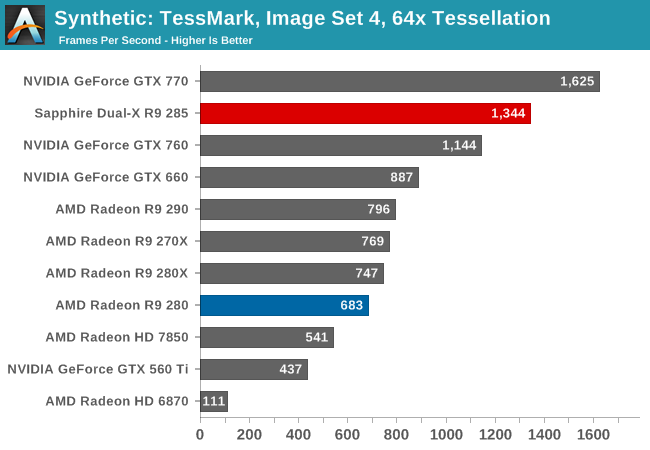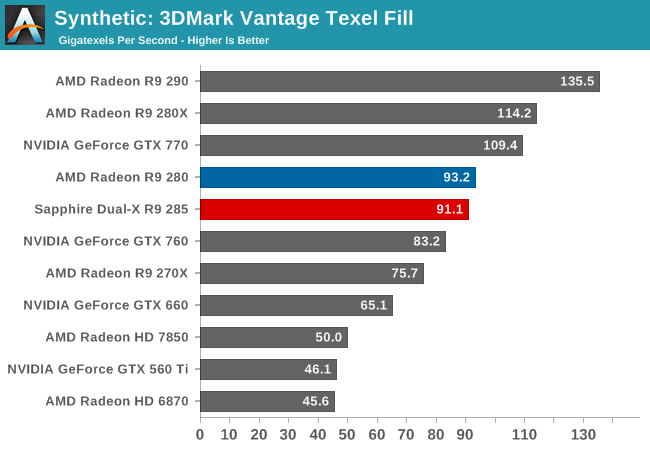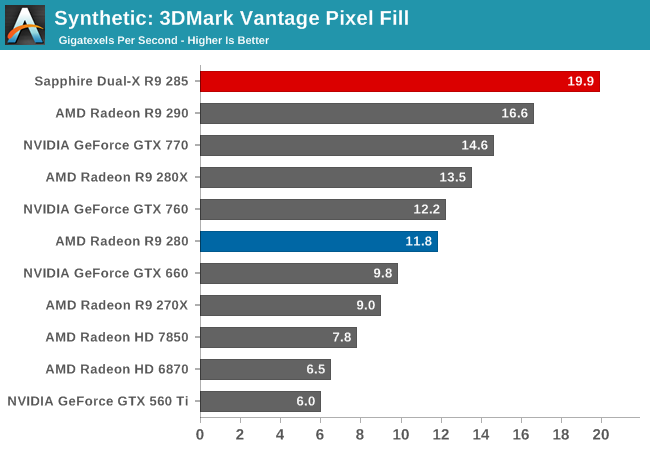AMD Radeon R9 285 Review: Feat. Sapphire R9 285 Dual-X OC
by Ryan Smith on September 10, 2014 2:00 PM ESTSynthetics
As always we’ll also take a quick look at synthetic performance. As we briefly discussed in our look at the GCN 1.2 architecture these tests mainly serve as a canary for finding important architectural changes, and one of these tests in particular has been significantly impacted by AMD’s newest round of architectural improvements.

At the x64 tessellation factor we see the R9 285 spit out 134fps, or equivalent to roughly 1.47B polygons/second. This is as compared to 79fps (869M Polys/sec) for the R9 290, and 68fps (748M Polys/sec) for the R9 280. One of the things we noted when initially reviewing the R9 290 series was that AMD’s tessellation performance didn’t pick up much in our standard tessellation benchmark (Tessmark at x64) despite the doubling of geometry processors, and it looks like AMD has finally resolved that with GCN 1.2’s efficiency improvements. As this is a test with a ton of small triangles, it looks like we’ve hit a great case for the vertex reuse optimizations.
Moving on, we have our 3DMark Vantage texture and pixel fillrate tests, which present our cards with massive amounts of texturing and color blending work. These aren’t results we suggest comparing across different vendors, but they’re good for tracking improvements and changes within a single product family.

With AMD maintaining their same texture units and same tex:FP32 ratio for Tonga, the end result is that R9 285’s texturing performance is virtually identical to R9 280’s. Ignoring any possibility of caching or bandwidth bottlenecking for the moment, R9 285 can push texels just as well as R9 280 could.

Unlike our texel test, AMD’s delta color compression technology introduced on GCN 1.2 has an incredible impact on R9 285’s pixel throughput. This pixel test is normally memory bandwidth bound, providing something that approaches a best case scenario for AMD’s compression technology. As a result despite possessing nearly 30% less memory bandwidth than the R9 280, the R9 285 tops our charts at 19.9 GPix/sec, blowing past the R9 280 by 68%. Even the R9 290 with its 512-bit memory bus and doubled ROP count still falls short here by over 3GPix/sec, or 16%.
This benchmark in a nutshell is why AMD can deliver the average performance of the Tahiti based R9 280 without Tahiti’s memory bandwidth. By improving their color compression to this point AMD can significantly reduce their memory bandwidth requirements on GCN 1.2, allowing them to do more with less. In real games the result won’t be anywhere near this remarkable since this is a pure pixel fillrate test, but it goes to show that AMD has been able to neutralize their memory bandwidth deficit in graphics workloads.










86 Comments
View All Comments
mczak - Wednesday, September 10, 2014 - link
This is only partly true. AMD cards nowadays can stay at the same clocks in multimon as in single monitor mode though it's a bit more limited than GeForces. Hawaii, Tonga can keep the same low clocks (and thus idle power consumption) up to 3 monitors, as long as they all are identical (or rather more accurately probably, as long as they all use the same display timings). But if they have different timings (even if it's just 2 monitors), they will clock the memory to the max clock always (this is where nvidia kepler chips have an advantage - they will stay at low clocks even with 2, but not 3, different monitors).Actually I believe if you have 3 identical monitors, current kepler geforces won't be able to stick to the low clocks, but Hawaii and Tonga can, though unfortunately I wasn't able to find the numbers for the geforces - ht4u.net r9 285 review has the numbers for it, sorry I can't post the link as it won't get past the anandtech forum spam detector which is lame).
Solid State Brain - Thursday, September 11, 2014 - link
A twin monitor configuration where the secondary display is smaller / has a lower resolution than the primary one is a very common (and logic) usage scenario nowadays and that's what AMD should sort out first. I'm positively surprised that on newer Tonga GPUs if both displays are identical frequencies remain low (according to the review you pointed out), but I'm not going to purchase a different display (or limit my selection) to get advantage of that when there's no need to with equivalent NVidia GPUs.mczak - Thursday, September 11, 2014 - link
Fixing this is probably not quite trivial. The problem is if you reclock the memory you can't honor memory requests for display scan out for some time. So, for single monitor, what you do is reclock during vertical blank. But if you have several displays with different timings, this won't work for obvious reasons, whereas if they have identical timings, you can just run them essentially in sync, so they have their vertical blank at the same time.I don't know how nvidia does it. One possibility would be a large enough display buffer (but I think it would need to be in the order of ~100kB or so, so not quite free in terms of hw cost).
PEJUman - Thursday, September 11, 2014 - link
I used multimonitor with AMD & NVIDIA cards. I would take that 30W hit if it means working well.NVIDIA: too aggressive with low power mode, if you have video on one screen & game on the other, it will remain at the clock speed of the 1st event (if you start the video before the game loading, it will be stuck at the video clocks).
I used 780TI currently, R9 290x I had previously works better where it will always clock up...
hulu - Wednesday, September 10, 2014 - link
The conclusions section of Crysis: Warhead seems to be copy-pasted from Crysis 3. R9 285 does not in fact trail GTX 760.thepaleobiker - Wednesday, September 10, 2014 - link
@Ryan - A small typo on the last page, last line of first paragraph - "Functionally speaking it’s just an R9 285 with more features"It should be R9 280, not 285. Just wanted to call it out for you! :)
Bring on more Tonga, AMD!
FriendlyUser - Wednesday, September 10, 2014 - link
I would like to note that if memory compression is effective, it should not only improve bandwidth but also reduce the need for texture memory. Maybe 2GB with compression is closer to 3GB in practice, at least if the ~40% compression advantage is true.Obviously, there is no way to predict the future, but I think your conclusion concerning 2GB boards should take compression in account.
Spirall - Wednesday, September 10, 2014 - link
If GCN1.2 (instead of a GCN 2.0) is what AMD has to offer as the new arquitecture for their next year cards, Maxwell (based in 750Ti x 260X tests), will punch hard AMD in terms of performance per watt and production cost (not price) so their net income.shing3232 - Wednesday, September 10, 2014 - link
750ti use a better 28nm process call HPM while rest of the 200 series use HPL , that's the reason why maxwell are so efficient.Spirall - Wednesday, September 10, 2014 - link
I'm afraid this won't be enough (but hope it does). Anyway, as Nvidia is expected to launch their Maxwell 256 bits card nearby, we'll have the answer soon.